Hardscape North America Education Gives Participants the Competitive Edge
New Presenters, Expanded Content & How-To Demos Make HNA a One-Stop Resource Louisville, Kentucky, (June 11, 2024)—From interactive demos to...
April Philips Describes Giving New Life to
an Expansive Historic Site in the Bay Area
A walk through Alameda Waterfront Park in California is a walk through time. Connections to the past, present and future abound in the former naval air station turned adaptive coastal community. Nods to the industrial ambiance that encompassed WWII personnel—and the marvelous, amphibious planes that defined the topography at the time—are accompanied by lush vegetation, convenient pathways, modern seating, endangered bird calls and inventive solutions to sea level changes anticipated from 2030 to 2050 to 2100.
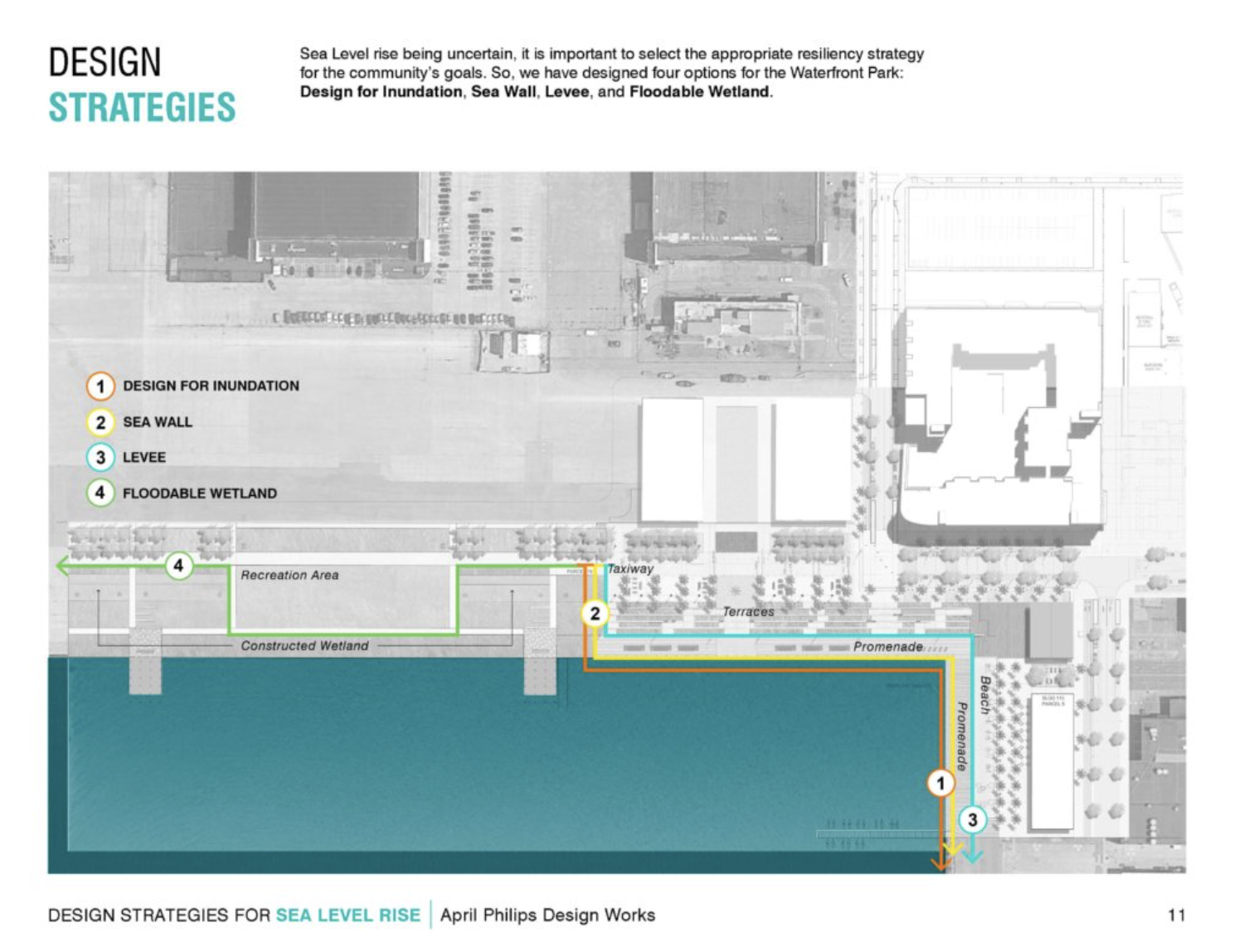
The transformation began in 2014, roughly 17 years after the closure of the revered military air base. This year marks the start of a complex, multi-phase development plan promising to reconfigure all of Alameda Point as a vast, mixed-use neighborhood. Aspects of the project remain ongoing with construction planned through summer 2024. To speak about her involvement in phase one—reimagining 68 acres of land included in site A—we interviewed April Philips, chair for the American Society of Landscape Architects’ Biodiversity & Climate Action Committee and founder of APDW, April Philips Design Works Inc.
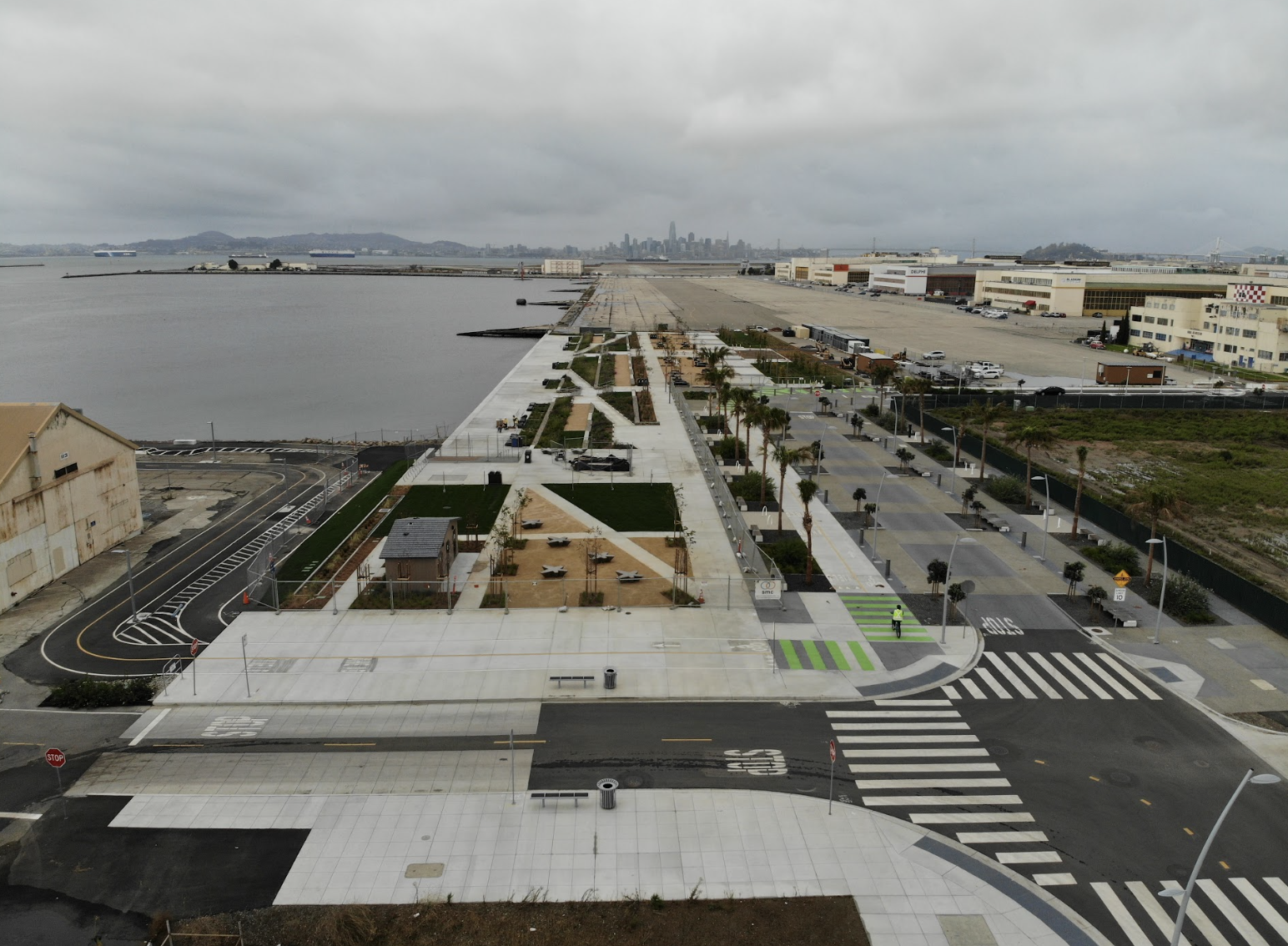
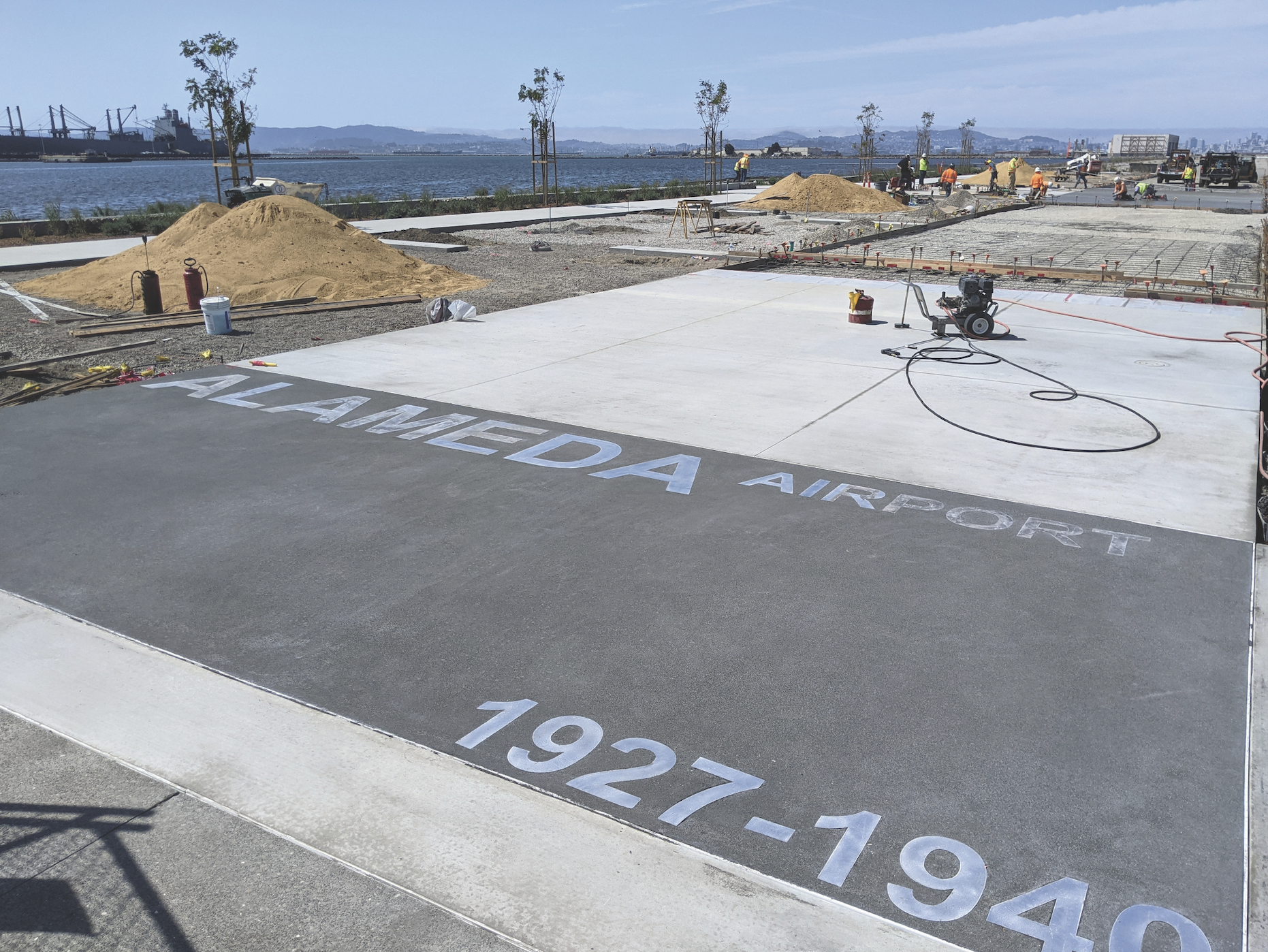
Construction Drone Shots
Photo courtesy of ©Alameda Point Partners LLC
As the local landscape architects and urban planners awarded Alameda Point site A, phase one, APDW was responsible for tasks, including but not limited to developing protection strategies for rising tides, providing green infrastructure and unearthing a cultural landscape. In total, this was a five-year process.
“Once we received the news that our multidisciplinary team had won, we worked with the city and the community, gathering their input to flesh out the 30 or so acres of nonresidential design,” says April. “We added more architects to our team because the city said we couldn’t just have one architect doing every building. Every other block had to be designed by a different architect.”
"We understood they wanted variety,
not just one cookie-cutter look."
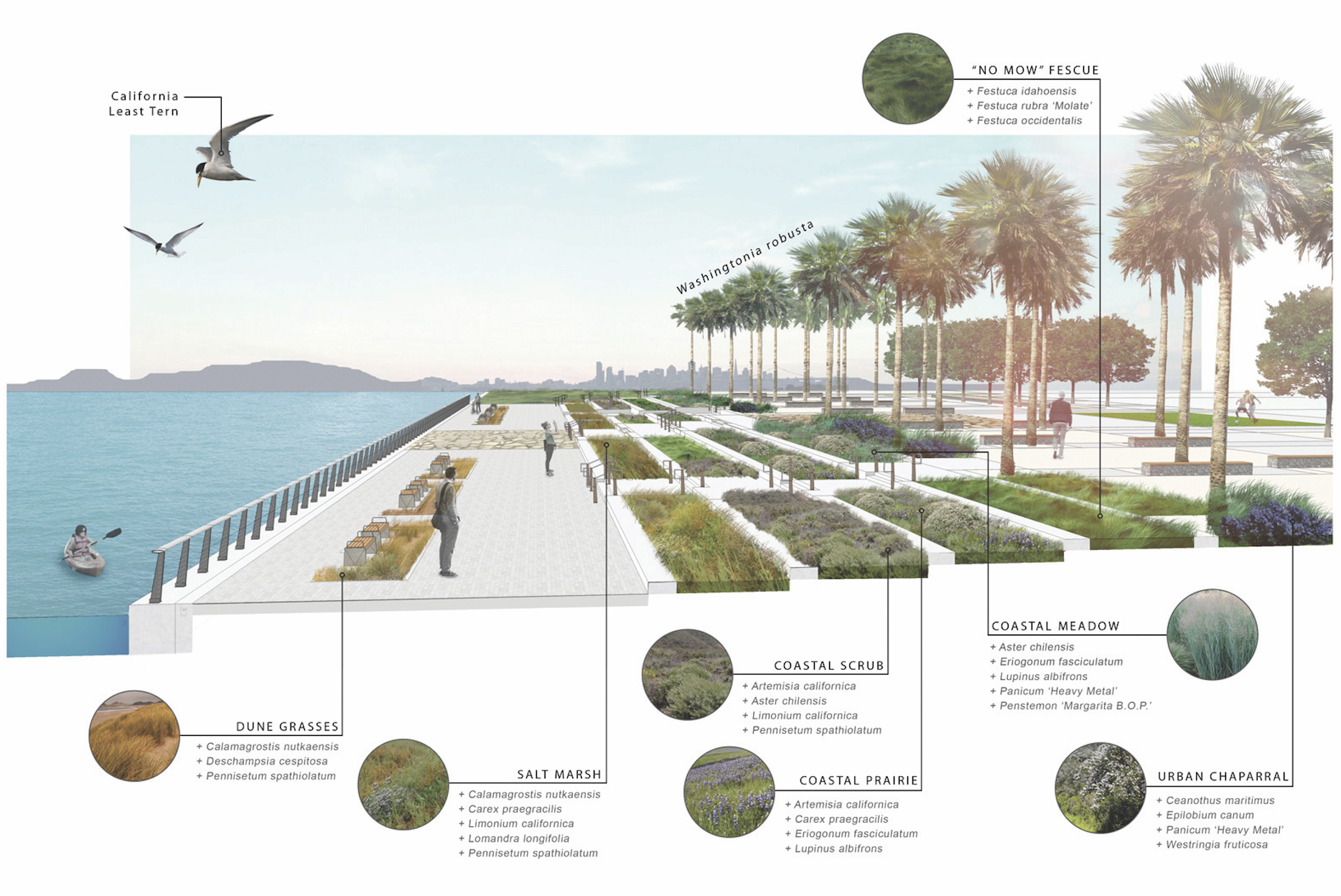
Plant Communities
.png?width=154&height=183&name=APDW%20(8).png) Obtaining a disposition development agreement with the city and the initial planning permit process in collaboration with the Bay Conservation and Development Commission, took about a year. Then came what April calls the design review stage, creating 3D models, developing vision studies and perusing all the different aspects of the project, ensuring that every piece aligned with the whole.
Obtaining a disposition development agreement with the city and the initial planning permit process in collaboration with the Bay Conservation and Development Commission, took about a year. Then came what April calls the design review stage, creating 3D models, developing vision studies and perusing all the different aspects of the project, ensuring that every piece aligned with the whole.
.png?width=2092&height=1390&name=APDW%20(6).png)
Photo courtesy of ©Gary Scharlach
“One of the most fun things we did was just taking photos and documenting everything we thought was interesting and wanted to save or add into the open space,” says April. “Between myself and the architect teams, we had this whole book of objects: markers, anchors, railroad ties, aviation lines, old buildings, hangars, the San Francisco skyline, colors, forms and materials. We took it all and brought that into our presentations. My fondest memory in the beginning was just the excitement of being there and seeing the layers of history, the patina of the past.”
.png?width=1862&height=1396&name=APDW%20(7).png)
.png?width=1866&height=1392&name=APDW%20(10).png)
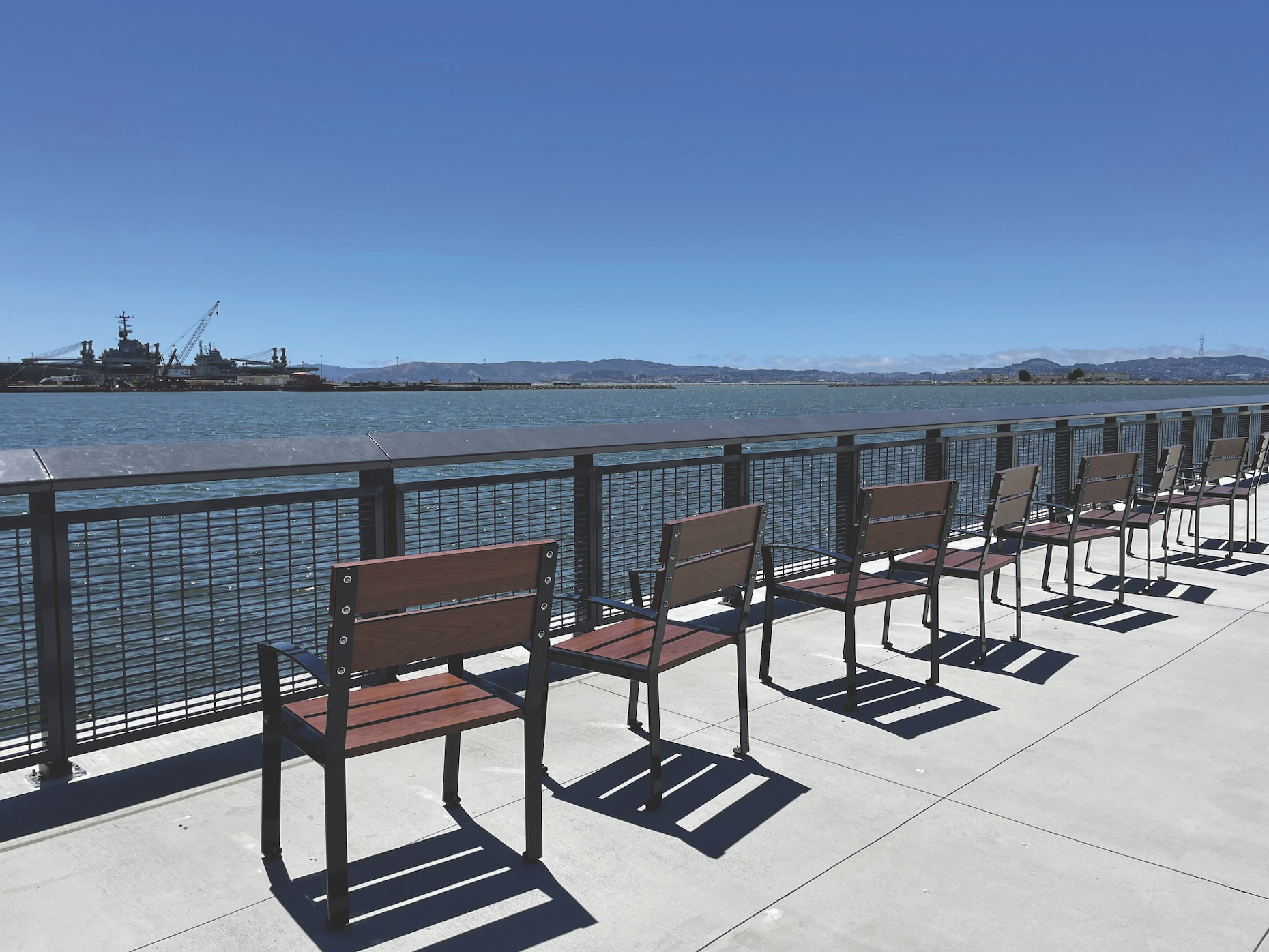
Photos courtesy of ©Gary Scharlach
.png?width=195&height=261&name=APDW%20(9).png) Today, a towering, Corten steel sculpture by artist Godfrey DeWitt, titled “Beken,” draws visitors toward the USS Hornet Museum. A timeline embedded in black concrete highlights milestones from days gone by. Real planes, sourced from the historic squadrons on base, were brushed with solar reflective paint and placed at four key landing nodes designed to optimize a plane-lover’s discovery process on a stroll through the park. Gabion walls, concrete barriers, metal picnic umbrellas, silk-screen images, steel mesh railings and wood benches—all these decisions branched from the book of inspiration collected at the start and are heightened by research related to extending the lifespan of materials in a corrosive oceanfront environment.
Today, a towering, Corten steel sculpture by artist Godfrey DeWitt, titled “Beken,” draws visitors toward the USS Hornet Museum. A timeline embedded in black concrete highlights milestones from days gone by. Real planes, sourced from the historic squadrons on base, were brushed with solar reflective paint and placed at four key landing nodes designed to optimize a plane-lover’s discovery process on a stroll through the park. Gabion walls, concrete barriers, metal picnic umbrellas, silk-screen images, steel mesh railings and wood benches—all these decisions branched from the book of inspiration collected at the start and are heightened by research related to extending the lifespan of materials in a corrosive oceanfront environment.
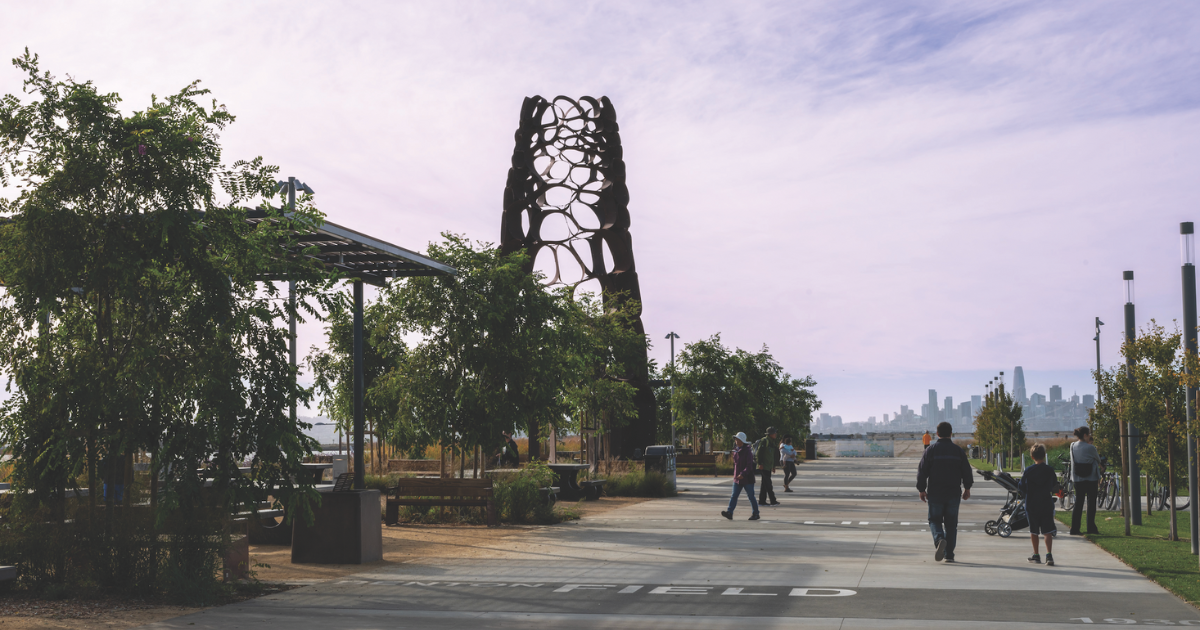
Beken by Godfrey DeWitt
Photo courtesy of ©Gary Scharlach
“It’s the kind of place that shouldn’t be sweet looking,” says April. “It should be rough and bold and certainly not over-designed. There were also a lot of environmental aspects to be aware of. For instance, endangered species affected by lighting, like the California least tern, needed to be considered.”
"Learning about it all was important for each team because we were all impacted by these issues."
.png?width=1864&height=1388&name=APDW%20(13).png)
.png?width=2306&height=1374&name=APDW%20(4).png)
Photo courtesy of ©Gary Scharlach
Aside from APDW, teams involved in phase one include Alameda Point Partners, the city of Alameda, BAR Architects, BKF Engineers, HLB Lighting, FARD Engineers, Peoples Associates Structural Engineers, Brookwater Irrigation, Langan and Suarez & Muñoz Construction. Each entity involved met regularly, donning masks in person or settling for Zoom meetings when the pandemic intruded. When asked for his take on the project, John Suarez of Suarez & Muñoz, had nothing but great things to say about working with APDW.
“We would have field meetings, and April would come down,” says John. “She was really good to work with. I remember that she had a clear vision for the project, but then she also understood construction. She knows that things come up where little changes and tweaks need to happen, and it’s important to make decisions. It helps the whole project move.”
.png)
.png?width=2016&height=1240&name=APDW%20(1).png)
Photos courtesy of ©Gary Scharlach
Likewise, one of the most significant takeaways April holds onto from this project is the relationships she developed. As the general contractor assigned to Alameda Waterfront Park, John and his team were responsible for all construction in this location, minus some prior remediation work. Because of the site’s age, Suarez & Muñoz faced unforeseen complications like removing abandoned utility lines. They also handled tasks like working with a fabricator to find a better, weld-free installation method for some powder-coated galvanized railings that would avoid exposing any portion of the metal to the elements.
.png?width=2110&height=1394&name=APDW%20(11).png)
Photo courtesy of ©Gary Scharlach
“I love to work with the contractors who have good values and want to work with you instead of fighting you,” says April. “I’ve had both. I’ve had contractors that don’t seem to want to work with me, and are always trying to show the clients that designers are wrong. This contractor was looking after the project. He was our best ally. We always found solutions together. I’ve tried to get them on other projects with me because we just made such a great team.”
.png?width=1858&height=1398&name=APDW%20(16).png)
.png?width=1858&height=1394&name=APDW%20(15).png)
Photos courtesy of ©Gary Scharlach
There are so many glowing beacons here that one article cannot reasonably fly to them all. Since its completion, Alameda Waterfront Park has received two awards from the American Society of Civil Engineers for Outstanding Community Improvement. Additionally, April says the full development plan received an endorsement from the Greenbelt Alliance as a “prime example of sustainable, equitable, transit-oriented development.” APDW’s work demonstrates the responsibility shared by all parties involved in reviving a landscape to pinpoint modifications owed to the land, both literally and in a commemorative sense.
.png?width=1684&height=1398&name=APDW%20(14).png)
Photo courtesy of ©Gary Scharlach
References:
More on Phase 1: https://apdw.com/portfolio/urban/alameda-point-site-a-phase-1/
Recent Updates: https://alamedapointinfo.com/
April Philips, PLA, FASLA, Owner for April Philips Design Works, Inc.
Email: aphilips@apdw.com
Phone: (415) 729–6033
www.apdw.com
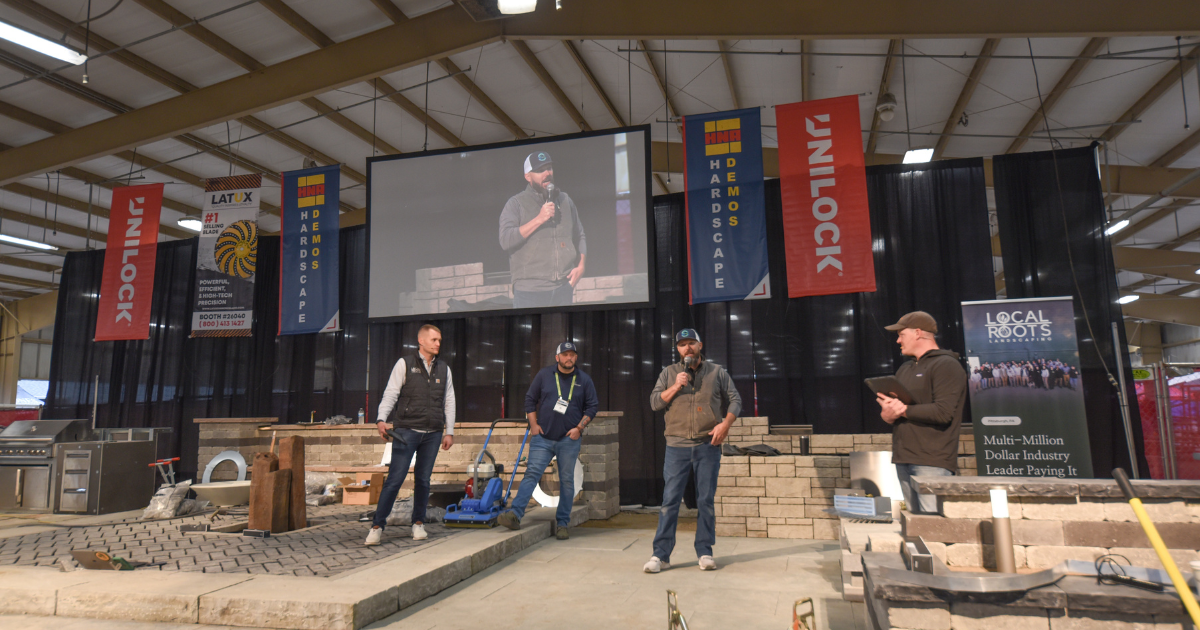
New Presenters, Expanded Content & How-To Demos Make HNA a One-Stop Resource Louisville, Kentucky, (June 11, 2024)—From interactive demos to...

2 min read
CMHA Releases 2025 Hardscape Contractor Industry Report, Highlighting Workforce Challengesand Industry Growth April 30, 2025 [HERNDON, VA]...